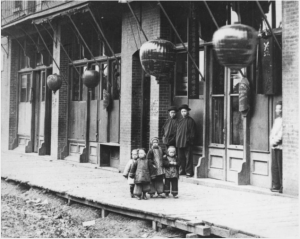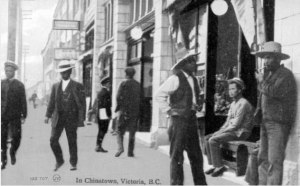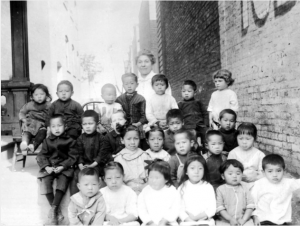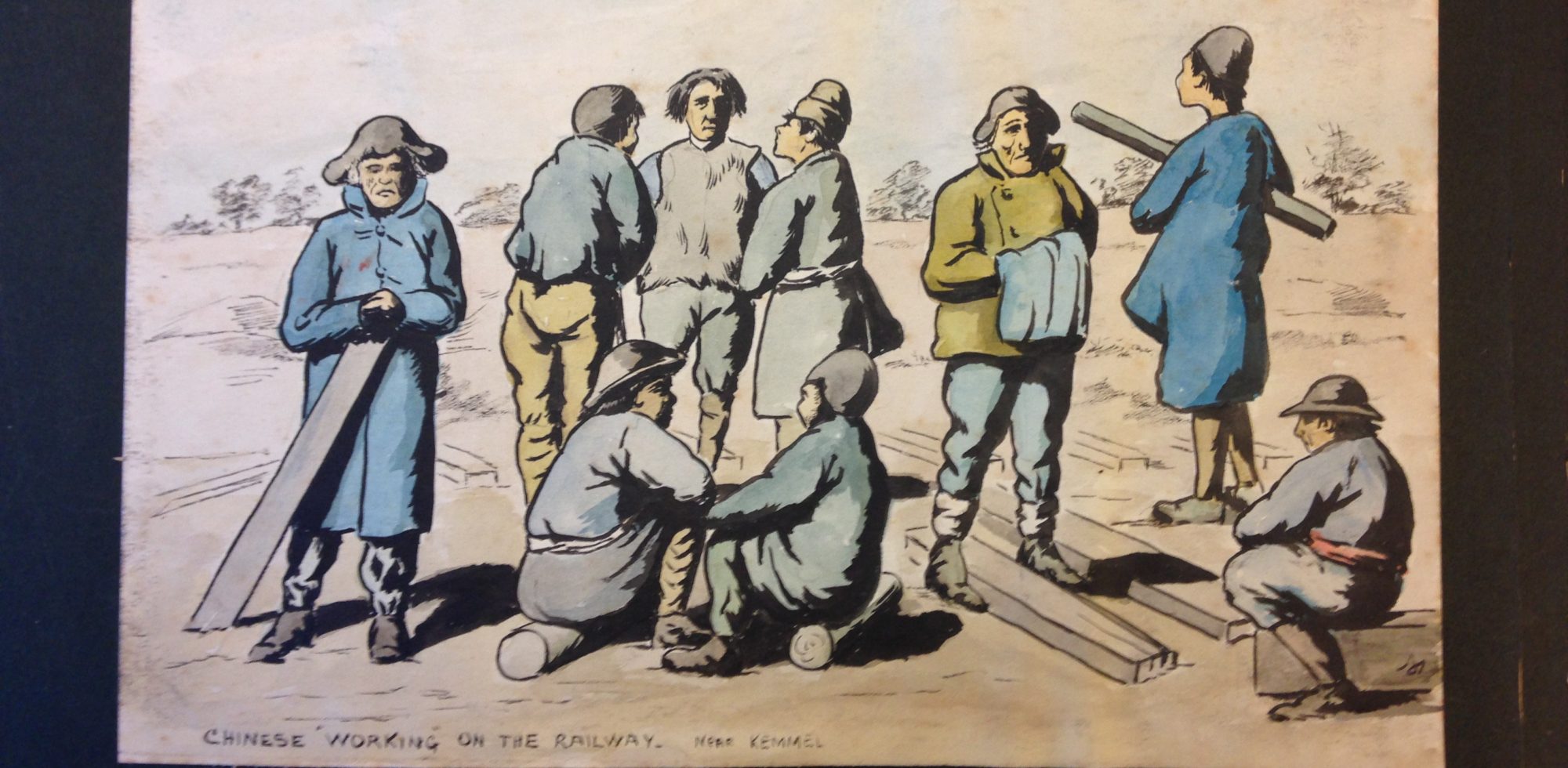
Chinese children on the sidewalk on Fisgard Street, ca. 1900. Image C-06727 courtesy of the Royal BC Museum and Archives.
In Victoria’s Chinatown, the war years were part of a larger growth trend that started in the late 1800s and early 1900s. The population and the number of families boomed prior to World War I, and while immigration slowed in the early years of the war, it increased again in the late 1910s.
With a boom in economic opportunities, Chinatown’s businessmen and Chinese Canadian labourers benefited from increased merchant activity and the shortage of workers during the war. Because of increasing population and economic success, this era continued earlier practices of forming various community organizations to link together immigrants in Canada and reinforce ties with the Chinese homeland.
Population Growth
Population Growth
In 1901, a City of Victoria census registered about 2,978 Chinese in the city; this was out of a total of 3,282 Chinese and Japanese Canadians recorded in Victoria by the Royal Commission on Chinese and Japanese immigration. The number could have been even higher, since many Chinese labourers left the city for seasonal labour in the summers when censuses were conducted.[1] In the decade leading up to World War I, approximately 33,000 Chinese immigrants entered Canada. They spread across the country, but the conditions of Victoria’s Chinatown were considered optimal compared Chinatowns elsewhere in North America, making it an ideal place for settlement.[2]
Increase in families
Before World War I, Victoria’s Chinatown, like most other Chinese Canadian communities, had a high gender imbalance. In 1911, there were 13 men to every woman and only 150 Canadian-born children in the community.[3] However, the war provided an unlikely opportunity to start and grow families. The war surprisingly made it easier for Chinese Canadian men to return home and reestablish connections with their families. Because of severe unemployment in the first years of the war, the Canadian government allowed Chinese immigrants to return home and spend more than 6 months out of Canada, a limit prior to the start of World War I, without having to re-pay the head tax upon arrival.[4] When returning to Canada, the men were easily able to bring their families, because women and children were exempt from the immigration head tax. This pattern was not unique to Victoria’s Chinatown, and the 1910s saw a dramatic increase in the number of women in Chinatowns across Canada, resulting in more families and more children.[5] By the 1920s, there were 6 men to every woman, and overall, during the WWI-decade, the largest proportion of population increase was female. [6]
Economic boom
With a growing, and increasingly permanent, population, commercial activity among the Chinese Canadian community in Victoria also increased. Victoria had been a busy shipping port since the completion of the Canadian Pacific Railway in 1885. After the railway was complete, many Chinese labourers stayed in Victoria and while they experienced a brief economic depression during the 1880s-90s, the economy rebounded and peaked during the 1910s with an emerging merchant class and the construction of many buildings in the Chinatown area.[7]

Victoria’s Chinatown was booming during the 1910s as economic activity increased. Image B-03974 courtesy of the Royal BC Museum and Archives.
Merchant growth
By 1911, there were over 79 merchant stores selling groceries and other goods, and there were more than 100 businesses total in Chinatown, double what was established in 1885.[8] These businesses tended to be family-owned partnerships. Anglo-Canadian banks would not often loan money to Chinese Canadians, so family partnerships provided ways to raise money and also ensure the success of the entire family. Different family members would get involved in different businesses, diversifying a family’s portfolio and extending their consumer base from solely the Chinese Canadian community to Anglo-Victorians as well.[9] In this period of growth, the war did impact the nature of merchant activities; restrictions on shipping meant that Chinese imported goods were scarce and businesses had to adapt, but the variety of business ventures ensured that most flourished during the war era.[10]
Employment for labourers
Despite the success of businesses, from 1914-1916 the community in Victoria’s Chinatown was hit hard by severe unemployment. Chinese Canadians were accused of stealing Anglo-Canadian jobs, and many Chinese community organizations encouraged immigrants to return home and lobbied the federal government to extend the duration immigrants could spend outside of Canada.[11]
However, within a few years, the fortunes of Chinese Canadian labourers improved. As the war went on, labour shortages increased and it reached a point where some BC farmers were so desperate for workers that they lobbied the federal government to waive the head tax so they could recruit more labourers.[12] While the farmers’ appeal never went anywhere, it marked a drastic departure from typical attitudes towards Chinese workers.
Growth of Social and Political Organizations
In addition to an increasing population and economic success, the strength of Victoria’s Chinatown increased as community and political organizations formed, crossing geographical, linguistic, and familial differences. There were 4 basic types of organizations:
- community-wide
- fraternal-political
- district (place of immigration)
- clan-based.[13]
Victoria’s Chinatown had a mix of all types, including community organizations like the Chinese Canadian Consolidated Benevolent Association founded in 1884, and over 10 different county- or district-based organizations by 1902.[14]

Community organizations, like the Chinese Consolidated Benevolent Association, operated schools for Chinese Canadian children, ca. 1915. Image C-07943 courtesy of the Royal BC Museum and Archives.
Political Organizations
During the World War I era, political organizations were the most prominent as “overseas” Chinese became involved in the 1911 Chinese Revolution and its aftermath. The earliest of these organizations in Victoria was the Chee Kun Tong society, founded in 1876 and would eventually focus on political change. In 1904, Sun Yat-Sen, the Chinese revolutionary, helped the society change its constitution. When he toured Canada in 1911, including stops in Victoria, to raise awareness and money for the 1911 Chinese Revolution, the Victoria Chee Kun Tong mortgaged their building and raised $12,000 for the revolution, out of a total $30,000 raised in Victoria and $70,000 raised across Canada.[15]
During the 1910s, other political associations also rose and fell. Supporting the Chinese empire’s ruling dynasty, the Chinese Empire Reform Association was founded in the 1890s and was prominent until the fall of the Manchu Empire in 1911.[16] After Sun Yat-Sen’s revolution was successful, Victoria’s Chinatown established a branch of the Kuomintang, Sun Yat-Sen’s revolutionary party. The Victoria branch even established its own newspaper, The New Republic, that acted as a medium to create community across different sections of the population.[17]
While these associations served to unite Chinese Canadians, not all agreed on political views and it even became violent at times. In 1916, members of the Kuomintang and the Chee Kong Tong clashed violently. This set of “tong wars” between the two parties throughout the 1910s happened not only in Victoria but also in Chinatowns across Canada.[18] After the 1910s, the primary focus of community organizations would shift from political positioning to shaping the Chinese Canadian role in white society, especially around the question of schooling.[19]
Footnotes
[1] David Chueyan Lai, Chinatowns: Towns Within Cities in Canada (Vancouver: UBC Press, 2000), ProQuest ebrary, 199.
[2] Charles Sedgewick, “Context of Economic Change and Continuity in an Urban Overseas Chinese Community,” 1970, CA UVICARCH AR113, University of Victoria Special Collections and University Archives, https://dspace.library.uvic.ca//handle/1828/3216, 11, 31.
[3] Lai, Chinatowns, 199, 202.
[4] Sedgewick, “Context of Economic Change and Continuity in an Urban Overseas Chinese Community,” 127.
[5] Edgar Wickberg, ed., From China to Canada: A History of the Chinese Communities in Canada (Toronto: McClelland and Stewart, 1982), 94-95.
[6] Lai, Chinatowns, 199. Sedgewick, “Context of Economic Change and Continuity in an Urban Overseas Chinese Community,” 127.
[7] Lai, Chinatowns, 198.
[8] Lai, Chinatowns, 218. Sedgewick, “Context of Economic Change and Continuity in an Urban Overseas Chinese Community,” 132.
[9] Lai, Chinatowns, 218. Sedgewick, “Context of Economic Change and Continuity in an Urban Overseas Chinese Community,” 133.
[10] Sedgewick, “Context of Economic Change and Continuity in an Urban Overseas Chinese Community,” 135.
[11] Patricia E. Roy, The Oriental Question: Consolidating a White Man’s Province, 1914-41 (Vancouver: UBC Press, 2014), ProQuest ebrary, 17.
[12] Roy, The Oriental Question, 23.
[13] Wickberg, From China to Canada, 106.
[14] Lai, Chinatowns, 204. Paul Yee, Chinatown: An Illustrated History of the Chinese Communities of Victoria, Vancouver, Calgary, Winnipeg, Toronto, Ottawa, Montreal and Halifax (Toronto: James Lorimer & Company Limited, 2000), 29.
[15] Lai, Chinatowns, 205-206. Wickberg, From China to Canada, 147.
[16] Lai, Chinatowns, 210.
[17] Lai, Chinatowns, 211. Sedgewick, “Context of Economic Change and Continuity in an Urban Overseas Chinese Community,” 149.
[18] Lai, Chinatowns, 211.
[19] Timothy Stanley, Contesting White Supremacy: School Segregation, Anti-Racism, and the Making of Chinese Canadians (Vancouver ; Toronto: UBC Press, 2011).
Primary author: Kate Siemens
